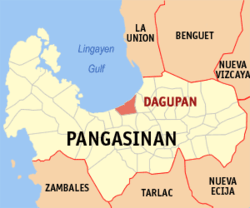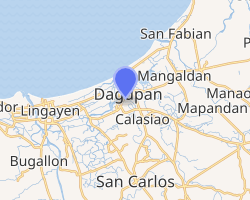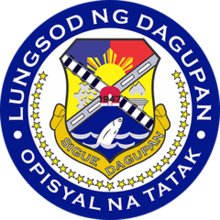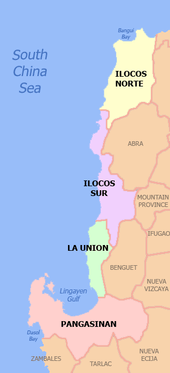Dagupan
Dagupan, officially the City of Dagupan (Pangasinan: Siyudad na Dagupan, Ilocano: Siudad ti Dagupan, Tagalog: Lungsod ng Dagupan), or simply referred to as Dagupan City, is a 1st class Independent Component city[7] in the province of Pangasinan, Philippines. According to the 2015 census, it has a population of 171,271 people.[4]
Dagupan | |
|---|---|
| City of Dagupan | |
Clockwise from top-left: Dagupan City Welcome Arch, Metropolitan Cathedral of Saint John the Evangelist, CSI Supermarket, Dagupan Train Museum | |
 Flag | |
| Nickname(s): Bangus (Milkfish) Capital of the Philippines[1] | |
 Map of Pangasinan with Dagupan highlighted | |
OpenStreetMap 
| |
.svg.png) Dagupan Location within the Philippines | |
| Coordinates: 16°02′N 120°20′E | |
| Country | |
| Region | Ilocos Region (Region I) |
| Province | Pangasinan (geographically only) |
| District | 4th district |
| Founded | 1590 |
| Cityhood | 20 June 1947 |
| Barangays | 31 (see Barangays) |
| Government | |
| • Type | Sangguniang Panlungsod |
| • Mayor | Marc Brian C. Lim |
| • Vice Mayor | Dean Bryan L. Kua |
| • Congressman | Christopher George Martin P. De Venecia |
| • Electorate | 119,164 voters (2019) |
| Area | |
| • Total | 44.47 km2 (17.17 sq mi) |
| Population (2015 census)[4] | |
| • Total | 171,271 |
| • Density | 3,900/km2 (10,000/sq mi) |
| • Households | 35,748 |
| Demonym(s) | Dagupeño (masculine) Dagupeña (feminine) Dagupenean |
| Economy | |
| • Income class | 1st city income class |
| • Poverty incidence | 9.21% (2015)[5] |
| • Revenue (₱) | 1,059,082,759.21[6] |
| Time zone | UTC+8 (PST) |
| ZIP code | 2400 |
| PSGC | |
| IDD : area code | +63 (0)75 |
| Climate type | tropical monsoon climate |
| Native languages | Pangasinan Ilocano Tagalog |
| Website | dagupan |
Located on the Lingayen Gulf on the northwest-central part of the island of Luzon, Dagupan is a major commercial and financial center north of Manila. Also, the city is one of the centers of modern medical services, media and communication in North-Central Luzon. The city is situated within the fertile Agno River Valley.
The city is among the top producers of milkfish (locally known as bangus) in the province. From 2001–2003, Dagupan's milkfish production totaled to 35,560.1 metric tons (MT), contributing 16.8 percent to the total provincial production. Of its total production in the past three years, 78.5 percent grew in fish pens/cages while the rest grew in brackish water fishponds.[8]
Dagupan is administratively and politically independent from the provincial government of Pangasinan and is only represented by the province's legislative district.
Dagupan City is one of the proposed metropolitan area in the Philippines.[9] Metro Dagupan is proposed to include the independent component city of Dagupan, as well as the towns of Lingayen, Binmaley, Calasiao, Mangaldan, Manaoag, Mapandan, San Fabian, San Jacinto, and Santa Barbara.
Etymology
The city's name was derived from the local Pangasinan word pandaragupan, meaning "gathering place" as the city has been a regional market center for centuries.
History
Kaboloan
During the 15th century, Pangasinan had been the site of an ancient polity called the Kaboloan. the Wangdom of Pangasinan sent emissaries to China in 1406–1411.[10]
Spanish occupation
The area that is now known as Dagupan was described as marshland thickly covered with mangrove and nipa palm trees.[11] The natives lived along the shoreline and riverbanks of Calmay, Pantal, and Bonuan. But there were also communities in Malued, Lasip, Pogo, and Bacayao. The natives called the area Bacnotan which would later be incorporated into the encomienda of Lingayen that was established in 1583.[12]
The first long distance railroad in the Philippines connecting Manila and Dagupan was opened on November 24, 1892.
Japanese Occupation
The Japanese planes bombed in Dagupan in December 1941; Dagupan was occupied by Japanese forces starting in 1942.[13]
Allied liberation
On January 8–January 9, 1945, U.S. General Douglas MacArthur landed his amphibious liberation force in the city's "Blue Beach" section along the Lingayen Gulf.[14][15] From his beachhead in Dagupan, along with those in neighboring towns Lingayen, Binmaley and San Fabian, MacArthur's forces under General Walter Krueger together with the Philippine Commonwealth troops under the Philippine Army and Philippine Constabulary units were able to penetrate Japanese defenses in Luzon island and liberate Filipino and allied prisoners of war near Cabanatuan in the province of Nueva Ecija, and in Manila's University of Santo Tomas, among others.
Dagupan's cityhood
Dagupan became a city by virtue of Republic Act No. 170, authored by Speaker Eugenio Pérez. It was signed into law by President Manuel Roxas on June 20, 1947.[16]
Contemporary history
The westward expansion of the city went as far as Lucao, which was also swampland. Local historian Restituto Basa surmised that the name Lucao may have been derived from the shellfish called lukan that used to abound in the swampy area.
In June 1962, Dagupan was shaken by a series of strong earthquakes which occurred at irregular intervals for about three weeks. The quakes toppled the belfry of the Roman Catholic Church. Many people from Calmay, Carael and island barrios evacuated to other towns.
In 1968, the national government agencies opened offices in Dagupan and other key cities across the country. The daytime population increased substantially, causing congestion in the city that began to see the appearance of public utility tricycles.
On July 16, 1990, a magnitude 7.7 earthquake struck northern Luzon, causing liquefaction, which made buildings tilt and sink due to their heavy weight and the looseness of the ground, which turned into sediment-rich mud. The Magsaysay Bridge, one of the two bridges especially spanning the Pantal River, collapsed, delaying people from crossing to the other banks and vice versa. Major damage caused businesses to be permanently transferred to the neighbouring towns of Mangaldan and Calasiao, but somehow, Dagupan and its inhabitants managed to recover from the earthquake.[17]
Geography
Dagupan City covers a total land area of 4,447.10 hectares (10,989.0 acres), bounded by the Lingayen Gulf in the north, San Fabian in the northeast, Mangaldan in the east, Calasiao in the south and Binmaley in the west. Land use is primarily for agriculture with 35.98% of the total land area, fishpond, cropland, residential with 22.88%; others uses are commercial, industrial, institutional, government private, parks and roads.
Barangays
Dagupan City is politically subdivided into 31 barangays.[18]
|
|
Climate
Dagupan City has a tropical monsoon climate (Köppen climate classification: Am). It is in Type I climate zone in the Modified Coronas' Climate Classification, with a pronounced dry season from November to April.
| Climate data for Dagupan City (1981–2010, extremes 1903–2012) | |||||||||||||
|---|---|---|---|---|---|---|---|---|---|---|---|---|---|
| Month | Jan | Feb | Mar | Apr | May | Jun | Jul | Aug | Sep | Oct | Nov | Dec | Year |
| Record high °C (°F) | 36.0 (96.8) |
37.0 (98.6) |
38.7 (101.7) |
39.9 (103.8) |
39.6 (103.3) |
38.7 (101.7) |
38.2 (100.8) |
36.4 (97.5) |
36.6 (97.9) |
37.2 (99.0) |
36.9 (98.4) |
36.9 (98.4) |
39.9 (103.8) |
| Average high °C (°F) | 30.8 (87.4) |
31.8 (89.2) |
33.2 (91.8) |
34.7 (94.5) |
34.1 (93.4) |
33.1 (91.6) |
32.0 (89.6) |
31.3 (88.3) |
31.6 (88.9) |
31.9 (89.4) |
31.8 (89.2) |
30.9 (87.6) |
32.3 (90.1) |
| Daily mean °C (°F) | 25.8 (78.4) |
26.5 (79.7) |
27.9 (82.2) |
29.5 (85.1) |
29.4 (84.9) |
28.9 (84.0) |
28.2 (82.8) |
27.8 (82.0) |
27.9 (82.2) |
27.9 (82.2) |
27.4 (81.3) |
26.2 (79.2) |
27.8 (82.0) |
| Average low °C (°F) | 20.7 (69.3) |
21.2 (70.2) |
22.6 (72.7) |
24.4 (75.9) |
24.8 (76.6) |
24.7 (76.5) |
24.4 (75.9) |
24.3 (75.7) |
24.2 (75.6) |
24.0 (75.2) |
23.0 (73.4) |
21.4 (70.5) |
23.3 (73.9) |
| Record low °C (°F) | 14.3 (57.7) |
16.3 (61.3) |
16.7 (62.1) |
19.7 (67.5) |
19.0 (66.2) |
20.2 (68.4) |
20.4 (68.7) |
19.0 (66.2) |
20.5 (68.9) |
19.5 (67.1) |
17.2 (63.0) |
15.2 (59.4) |
14.3 (57.7) |
| Average rainfall mm (inches) | 6.7 (0.26) |
10.7 (0.42) |
22.2 (0.87) |
60.4 (2.38) |
209.8 (8.26) |
337.9 (13.30) |
499.6 (19.67) |
581.3 (22.89) |
368.4 (14.50) |
215.9 (8.50) |
53.9 (2.12) |
14.1 (0.56) |
2,380.9 (93.74) |
| Average rainy days (≥ 0.1 mm) | 1 | 1 | 2 | 5 | 12 | 17 | 21 | 22 | 20 | 11 | 5 | 2 | 119 |
| Average relative humidity (%) | 79 | 78 | 77 | 77 | 79 | 83 | 86 | 87 | 86 | 84 | 82 | 80 | 82 |
| Source: PAGASA[20][21] | |||||||||||||
Demographics
|
| |||||||||||||||||||||||||||||||||||||||||||||
| Source: Philippine Statistics Authority[4][19][22][23] | ||||||||||||||||||||||||||||||||||||||||||||||
In Dagupan, the Pangasinans are the predominant people and the Pangasinan language is predominantly used in the city and environs, followed by English and Filipino, as well as Ilocano. Chinese is mainly spoken only by a few city individuals of Chinese descent.
- Number of Registered Voters (2016): 105,183[18]
Economy
_(Dagupan%2C_Pangasinan)(2018-02-25).jpg)
Dagupan is the economic center of Pangasinan and the rest of North-Central Luzon region.[24] As a major regional hub, many people in Pangasinan and nearby provinces commute to the city during the day. This causes the city's daytime population to rise and cause traffic to parts of the city, especially the downtown area. The city is a vital financial center housing numerous banks, non-bank financial institutions, headquarters of corporations and offices of major government departments and agencies.
Historically, Dagupan was a center for salt making in numerous salt evaporator beds in the low-lying swampy areas close to the Lingayen Gulf, Beginning in the 19th Century, some of the salt making operations gave way to pond culture of fish, most prominently the milkfish or as it is known locally as bangus for which the city has become famous. Fisheries, aquaculture and processed fisheries products are an important mainstay of the city's economy.[25]
Manila-based developers have also set shop in this bustling city due to its strategic location and growing population.
▪ Santa Lucia Land Inc. (Almeria Verde Subdivision)[26]
▪ Double Dragon Properties (CityMall Mayombo, opened 2018)
▪ SM Prime Holdings (SM Center Dagupan [opened 2019], planned SM Savemore Dagupan, and planned SM City Dagupan)[26]
▪ 11-storey Allied Care Experts Medical Center[26]
▪ Green Sun Management Inc. & Megaworld Construction and Development Corporation (5 storey Green Sun Hotel)[27]
▪ Filinvest (Fora Dagupan - a 6.3 hectare Townscape development)[28]
▪ Vester Corporation - Bayani Hall condominium, Arellano St., Dagupan City[29]
As of June 2020, Dagupan is one of the 25 cities in the country identified as an area with “high-potential in IT-BPM industry” for transformation into “digital cities” by 2025.[30]
Sitel, a global business process outsourcing (BPO) firm, has recently opened its first Sitel MAXhub in Dagupan City, bringing more jobs to aspiring BPO professionals in Dagupan city. The company is now actively seeking to expand more in the city.[31]
Local businessmen have also went with the trend in developing their properties in different locations which further boosts the city's construction activities and secures the city's title as the economic hub of Pangasinan.
Another part of Dagupan's economy is the motor vehicle industry. Many automotive companies have a dealership in the city's metropolitan area. Existing car dealerships from major companies including Ford, Hyundai, Chevrolet, Mazda and Izuzu are all found in Dagupan, while other companies such as Toyota, Honda, Mitsubishi, Nissan and many more are found at the neighbouring town of Calasiao.
Transportation
Dagupan is connected with other cities by networks of national roads. Romulo Highway and Pangasinan - La Union Road (N55) and Urdaneta - Dagupan Road (N56) are the principal highways that serve the city.
The Philippine National Railways (PNR) once served Dagupan through Dagupan station, that went defunct in the late 1980s. The first railroad in the Philippines, the Manila-Dagupan Railway, terminated at the city.
Intercity/interprovincial buses from Manila serve the city, and are usually operated by Dagupan Bus Company, Victory Liner, Five Star, and Pangasinan Solid North. Jeepneys provide intracity travel, as well as for towns and cities of close proximities.
Health
Medical and health service centers abound in Dagupan. Out of 51 hospitals in Pangasinan, 12 are located in the city. The largest of these is the Region 1 Medical Center with hospital bed capacity of 1000.
Education
Since the colonial era, Dagupan has always been the center of education in Ilocos Region (Region 1). The private sector-driven centers of education University of Pangasinan, University of Luzon and Lyceum-Northwestern University lead, 14 colleges and 18 vocational schools and 3 technical learning centers, 19 secondary schools and 53 elementary schools both in public and private.
Colleges and universities
Public secondary schools
|
Private primary and secondary schools
|
Media
Dagupan City is home to regional television stations of GMA Network, CNN Philippines, TV5, IBC 13 and ABS-CBN, nineteen radio broadcasting stations (9 AM and 10 FM), at least seventeen local newspapers and three cable television companies. There are two news programs TV Patrol North Luzon (ABS-CBN TV-32 Dagupan) and Balitang Amianan (GMA Dagupan).
Sister cities





References
- Visperas, Eva (29 January 2017). "Dagupan makes strides in bangus deboning". The Philippine Star. Archived from the original on 28 January 2017. Retrieved 19 April 2019.
- "City". Quezon City, Philippines: Department of the Interior and Local Government. Retrieved 30 May 2013.
- https://www.dagupan.gov.ph
- Census of Population (2015). "Region I (Ilocos Region)". Total Population by Province, City, Municipality and Barangay. PSA. Retrieved 20 June 2016.
- "PSA releases the 2015 Municipal and City Level Poverty Estimates". Quezon City, Philippines. Retrieved 1 January 2020.
- |url=https://www.coa.gov.ph/index.php/local-government-units/2019/category/8265-pangasinan#
- http://pangasinan.gov.ph/the-province/cities-and-municipalities/dagupan-city/
- "Dagupan City: The Home of the World’s Longest Barbecue" Archived 2014-07-26 at the Wayback Machine. National Statistical Coordination Board Profile. Retrieved on 2012-05-30.
- Dagupan Metropolitan Area or Metro Dagupan (DMA) is a metropolitan area in north central Luzon http://wowdagupantoday.blogspot.com/2011/01/new-metropolis-rising-in-pangasinan.html
- Scott, William Henry (1989). "Filipinos in China in 1500" (PDF). China Studies Program. De la Salle University. p. 8. Archived from the original (PDF) on 2015-07-24. Retrieved 2015-07-24.
- "Dagupan City in Pangasinan Luzon PhilippinesPhilippines". www.philippine-islands.ph. Archived from the original on 2015-12-08. Retrieved 2015-11-27.
- "Physiographic Setting of Affected Areas". Philippine Institute of Volcanology and Seismology. Retrieved 27 July 2019.
In 1590, the house clusters were resettled into compact communities and converted into a town named initially as Bacnotan and renamed later in 1720 as Dagupan.
- "Reporter Predicted Japanese Attack - Pearl Harbor - Hector C. Bywater". www.lindseywilliams.org. Retrieved 2015-11-27.
- "MacArthur landed in Dagupan, not Lingayen". The Philippine Star. 10 January 2017. Retrieved 27 July 2019.
- Cosgrove, Ben (10 November 2014). "LIFE With MacArthur: The Landing at Luzon, the Philippines, 1945". Time. Retrieved 27 July 2019.
- "Republic Act No. 170 - An Act Creating the City of Dagupan". Chan Robles Virtual Law Library. Retrieved 31 January 2016.
- Gabriel Cardinoza (July 24, 2012). "Dagupan Rises From 1990 Nightmare". Philippine Daily Inquirer.
- "Municipality/City: Dagupan City" Archived 2012-05-10 at the Wayback Machine. PSGC Interactive. Retrieved on 2012-05-29.
- Census of Population and Housing (2010). "Region I (Ilocos Region)". Total Population by Province, City, Municipality and Barangay. NSO. Retrieved 29 June 2016.
- "Dagupan City, Pangasinan Climatological Normal Values". Philippine Atmospheric, Geophysical and Astronomical Services Administration. Archived from the original on 11 October 2018. Retrieved 11 October 2018.
- "Dagupan City, Pangasinan Climatological Extremes". Philippine Atmospheric, Geophysical and Astronomical Services Administration. Archived from the original on 11 October 2018. Retrieved 11 October 2018.
- Censuses of Population (1903–2007). "Region I (Ilocos Region)". Table 1. Population Enumerated in Various Censuses by Province/Highly Urbanized City: 1903 to 2007. NSO.
- "Province of Pangasinan". Municipality Population Data. Local Water Utilities Administration Research Division. Retrieved 17 December 2016.
- https://www.nicp.org.ph/next-cities/dagupan-city. Missing or empty
|title=(help) - "Aquaculture in Dagupan City, Philippines". World Aquaculture 29(1):18-24. March 1998. Retrieved 3 Jul 2018.
- https://punch.dagupan.com/articles/news/2019/01/major-estate-developers-bullish-on-pangasinan-dagupan/. Missing or empty
|title=(help) - https://wwwmortzcortigoza.blogspot.com/2019/02/more-investors-coming-in-dagupan-city.html?m=1. Missing or empty
|title=(help) - https://www.dagupan.gov.ph/filinvest-unveils-fora-dagupan-project/. Missing or empty
|title=(help) - https://www.vester.com.ph/. Missing or empty
|title=(help) - https://www.pna.gov.ph/articles/1107517. Missing or empty
|title=(help) - https://philippines.sitel.com/sitel-offers-more-work-from-home-opportunities-with-the-launch-of-maxhubs/. Missing or empty
|title=(help) - "Sister Cities, Public Relations". Guadalajara municipal government. Archived from the original on March 2, 2012. Retrieved March 12, 2013.
- "30th year of Dagupan-Iwata sisterhood pact celebrated". Sunday Punch Line. Retrieved December 4, 2013.
- "Dagupan, Milpitas renew sisterhood pact – Sunday Punch". punch.dagupan.com. Retrieved 2016-07-04.
- www.taoti.com, Taoti Creative, Washington DC / May 2012 /. "Interactive City Directory". www.sister-cities.org. Archived from the original on 2016-08-17. Retrieved 2016-07-04.
Further reading
- Basa, Restituto (1972). Story of Dagupan. Manaois Press.
External links
| Wikivoyage has a travel guide for Dagupan. |
| Wikimedia Commons has media related to Dagupan. |


